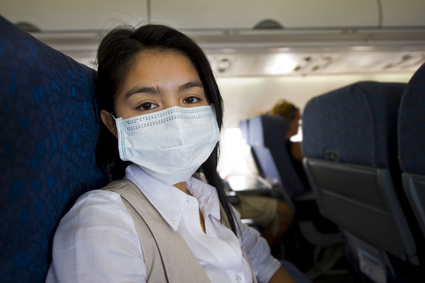
Newsletter Subscribe
Enter your email address below and subscribe to our newsletter

Enter your email address below and subscribe to our newsletter

It’s a bird, it’s a plane…it’s bacteria!! Air travel is extremely accessible today and links countries all over the world. You can wake up in New York and go to sleep in Tokyo; any destination is possible. With the convenience of air travel, comes the risk of spreading diseases more easily. Now not only do over a million people take flight each day, but so do a wide variety of germs, influenzas and illnesses.
We’ve all heard the stories surrounding the recent Corona Virus and we are all too familiar with the SARS outbreak in 2002. People are in constant movement through air travel, so it’s no wonder there is concern surrounding the containment of these illnesses and how to prevent them from spreading rapidly through our skies. But what about the prevention of everyday viruses on planes; How likely are you to catch the common cold on your next flight, and what are airlines doing to help stop the spread of germs? Can flying make you sick?
Consider the entire trip, including buses, trains, taxis, public waiting areas, etc. If you’ve ever been unfortunate enough to contract a virus while traveling, the question then needs to be asked, where did you first come in contact? The total travel experience must be taken into consideration before assuming the illness was a direct result of air travel.
Breathe easy!! All commercial jet aircraft recirculate 10%-50% of the air in the cabin and mix it with outside air. The recirculated air then passes through a series of HEPA filters, helping capture 99.9% of particles containing bacteria, fungi and larger viruses. Air does not flow up and down the aisle; it flows diagonally in small sections. This helps to create an environment that is unfavorable to the spread of most illnesses.
The EPA (Environmental Protection Agency) regularly tests the water supply onboard all commercial aircraft carriers. Their aim is to provide the public with additional protection from disease-causing organisms like E. coli and other pathogens, which can sometimes be found in onboard water supplies. If bacteria are present, the airline must then deactivate the plane’s water system and have it decontaminated.
If a serious illness or infection is suspected on board a flight, a procedure is then put into place to help eliminate the spread of any harmful bacteria. The captain of any aircraft bound for the United States, is required by law to notify the Center for Disease Control and Prevention of any suspected ill passengers or passengers who may have died onboard the flight before arrival. If this occurs, the plane must then be decontaminated and passengers would need to be assessed.

Although airlines have taken measures to cut down the spread of germs, the fact is, planes are in constant motion and don’t always have time for a thorough cleaning after each flight. Most airlines only require their planes to be deep-cleaned (lavatories, seat covers, tray tables) every 30 days and perform light-cleans every 2 weeks. Germs can therefore linger on toilets, tray tables and handles for weeks before being properly scrubbed. So how do you stay healthy on your next flight, and ensure you return home germ free?
When flying at high altitudes, the humidity levels can cause your nose and throat to get dry. When our nasal passages don’t have enough moisture, our bodies can’t flush out harmful bacteria and viruses. Drinking lots of water allows our mucus membranes to stay hydrated, creating a better environment to fight germs.
Think about all the previous passengers who sat in your seat. Use hand sanitizer before eating, and avoid touching your face, mouth and nose. If you happen to have disinfectant wipes with you, wipe down your armrests, table trays and TV screen before taking your seat.
The window seat can be a great place for those wanting to take in the views or rest their head during sleep; but it can also be a great place to pick up germs. Bacteria can linger on surfaces for long periods of time, so avoid close contact with the window if possible.
You can’t always pick your seat-mate and may find yourself sitting next to someone with the sniffles. To avoid sharing the germs of those around you, turn the air above your head to a medium flow to ensure circulation, but avoid pointing it directly towards your face.
To ensure you don’t take away any unwanted germs, find the nearest lavatory once off the plane, and wash your hands thoroughly with warm water and soap. Diligent hand washing and use of hand sanitizers is always the best way to ward off infection.
Realistically we can’t always change our travel plans when we are sick, but we can however avoid trying to spread our germs to others. If you find yourself sick with a mild cold while traveling, be sure to wash your hands often and cover your mouth when coughing. If you’re ill with a much more contagious disease, please avoid flying all together! Airlines will help to rebook you when you are too sick to travel. Remember, just because your body can fight off a very serious infection, doesn’t mean the elderly lady or young child sitting next to you can!
Have you ever caught a virus due to air travel? If so, we’d love to hear! Share your story below!